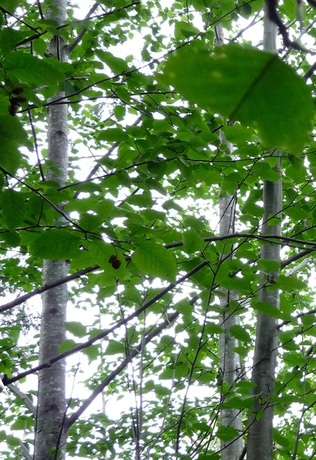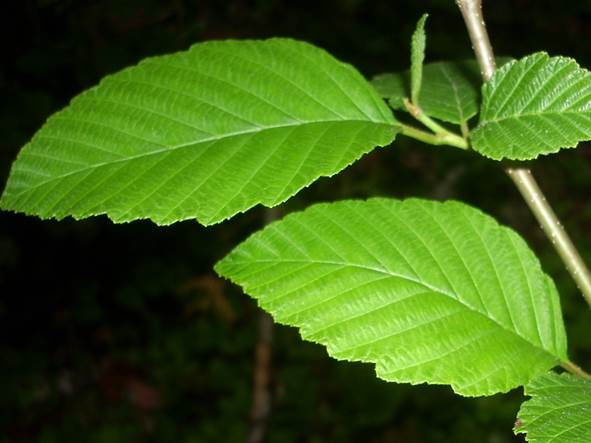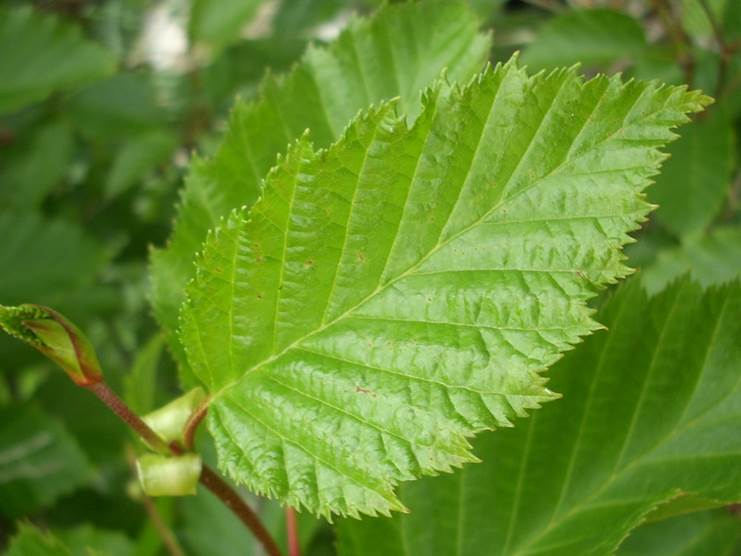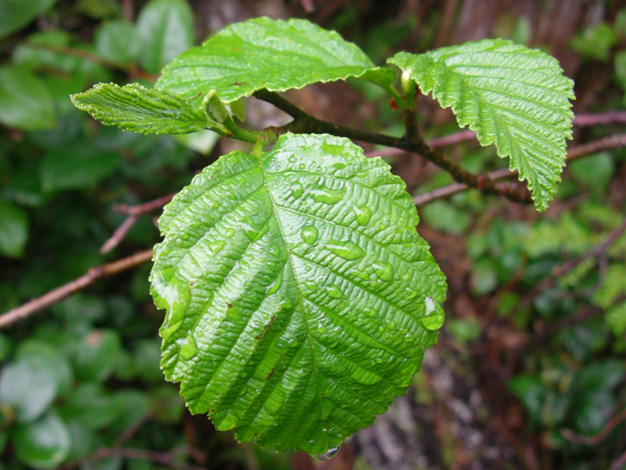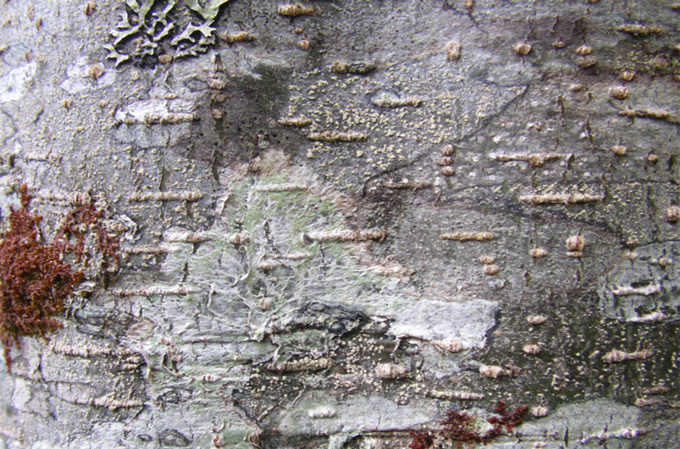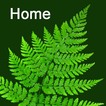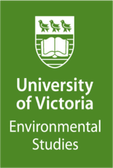Red alder • Alnus rubra
|
Top left: red alder trees photographed by Chanda Brietzke. Right: red alder leaves and bark photographed by Peter Gibbs. Bottom left: a comparison of red alder leaves (far left), which are coarse and bluntly toothed, with Sitka alder leaves (near left) which are more finely toothed. Photos by Julie Mundy.
|
Identification
This deciduous tree grows to 25 m tall, and has thin grey to yellow-brown bark that is often covered with white patches of lichen. The bark is initially smooth but becomes more scaly with age. The leaves of the red alder are an important distinguishing feature, especially near the coast. Red alder leaves are coarsely, bluntly-toothed, with rolled under margins and pointed ends. They grow in an alternating pattern off the branch. Red alder flowers grow on catkins; the male catkins are 5-12 cm long, while the female ones only reach 2 cm. The cones are similar in size to the female catkins and stay on the tree throughout winter.
Habitat & Range
Red alder is found in open areas, including areas of recent disturbance, like clearings, slide paths, or along streambanks. It can form extensive stands in moist woods at low elevations. Red alder is found throughout coastal BC, and extends north to Alaska and south to California.
Similar Species
Sitka alder (Alnus viridis ssp. sinuata) is often co-occurring with red alder, or in close proximity. Sitka alder generally grows at the interface of beach and forest along the BC coast, and is a much shrubbier, shorter species than the tall, straight red alder. The leaves are a distinguishing feature between the two as well. As seen in the photos above, Sitka alder leaves are much more finely saw-toothed than the coarse, bluntly-toothed red alder leaves.
Human Uses
Many alder species were used by Indigenous Peoples in various ways across their ranges. The bark of alder was traditionally used to produce a red or brown dye for fishnets and cedar bark. The inner bark and juice from the bark was used directly or in ointments to treat skin problems, and the aged bark as a cure for internal ailments including diarrhea and constipation.
The Quileute of Washington ate raw cones to prevent dysentery, and the Klallam of the Olympic Peninsula and southern Vancouver Island chewed catkins as a cure for diarrhea. Other uses included making drinks from leaves, roots and stems to treat various ailments. Alder wood was prized as firewood and usually used for smoking salmon.
This deciduous tree grows to 25 m tall, and has thin grey to yellow-brown bark that is often covered with white patches of lichen. The bark is initially smooth but becomes more scaly with age. The leaves of the red alder are an important distinguishing feature, especially near the coast. Red alder leaves are coarsely, bluntly-toothed, with rolled under margins and pointed ends. They grow in an alternating pattern off the branch. Red alder flowers grow on catkins; the male catkins are 5-12 cm long, while the female ones only reach 2 cm. The cones are similar in size to the female catkins and stay on the tree throughout winter.
Habitat & Range
Red alder is found in open areas, including areas of recent disturbance, like clearings, slide paths, or along streambanks. It can form extensive stands in moist woods at low elevations. Red alder is found throughout coastal BC, and extends north to Alaska and south to California.
Similar Species
Sitka alder (Alnus viridis ssp. sinuata) is often co-occurring with red alder, or in close proximity. Sitka alder generally grows at the interface of beach and forest along the BC coast, and is a much shrubbier, shorter species than the tall, straight red alder. The leaves are a distinguishing feature between the two as well. As seen in the photos above, Sitka alder leaves are much more finely saw-toothed than the coarse, bluntly-toothed red alder leaves.
Human Uses
Many alder species were used by Indigenous Peoples in various ways across their ranges. The bark of alder was traditionally used to produce a red or brown dye for fishnets and cedar bark. The inner bark and juice from the bark was used directly or in ointments to treat skin problems, and the aged bark as a cure for internal ailments including diarrhea and constipation.
The Quileute of Washington ate raw cones to prevent dysentery, and the Klallam of the Olympic Peninsula and southern Vancouver Island chewed catkins as a cure for diarrhea. Other uses included making drinks from leaves, roots and stems to treat various ailments. Alder wood was prized as firewood and usually used for smoking salmon.
References
Alnus rubra Bong. red alder. In Klinkenberg, Brian. (Ed.). E-Flora BC: Electronic Atlas of the Plants of British Columbia. Lab for Advanced Spatial Analysis, Department of Geography, University of British Columbia, Vancouver. Accessed on 26/04/2013.
Pojar, J. and MacKinnon, A. (2005). Plants of Coastal British Columbia, Revised. Vancouver, BC: Lone Pine Publishing. P. 44.
Authors and editors of page
Chanda Brietzke, Kelly Fretwell, and Brian Starzomski (2016).
Alnus rubra Bong. red alder. In Klinkenberg, Brian. (Ed.). E-Flora BC: Electronic Atlas of the Plants of British Columbia. Lab for Advanced Spatial Analysis, Department of Geography, University of British Columbia, Vancouver. Accessed on 26/04/2013.
Pojar, J. and MacKinnon, A. (2005). Plants of Coastal British Columbia, Revised. Vancouver, BC: Lone Pine Publishing. P. 44.
Authors and editors of page
Chanda Brietzke, Kelly Fretwell, and Brian Starzomski (2016).
